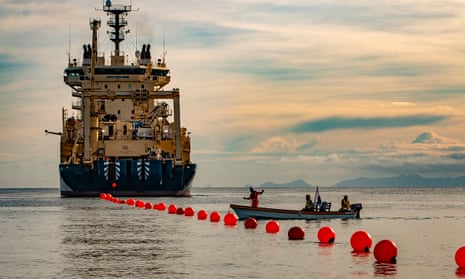From the narrow bay of Sydney’s Tamarama Beach, a cable twice as thick as garden hose, carrying optic fibre thinner than human hair, stretches along the ocean floor linking Australia to Papua New Guinea and Solomon Islands.
The Coral Sea cable will provide, for the first time, fast internet to Australia’s near Pacific island neighbours. A similar link, called Manatua One Polynesia – connecting Samoa, Niue, the Cook Islands and French Polynesia – was declared “ready for service” in July.
But a new report from Western Sydney University, Plan International, and Child Fund Australia says the Pacific’s emerging connectivity boom brings with it both opportunity and risk, with particular concern for the safety of women and girls online.
Researchers found while both children and adults welcomed opportunities for education, social connectivity, and entertainment, many held concerns: 77% of children surveyed said they feared accessing inappropriate content like horror movies or pornography, while 38% said they were concerned about cyber-bullying.
Parents and carers identified a lack of control over what children accessed as their greatest fear.
Craig Gibson is the principal of Kimbe International School, in PNG’s remote New Britain province. In March, he was delighted to learn that the cable had finally connected. His school, privileged by local standards, has internet speeds so slow that it takes six hours to download a YouTube video.
And while there have been delays in delivering promised internet speeds to PNG, Gibson remains optimistic.
“It’ll make a huge difference. It’ll allow teachers to use more resources, kids to complete online learning,” he said.
Despite his excitement, he holds concerns too for what modern internet will mean for a community that has had little exposure to the digital world.
“We already have problems with people opening anything, people blindly trusting what’s online. I’m also concerned about cyber-bullying for both adults and kids.”
Prof Amanda Third, co-director at the Young and Resilient research centre at Western Sydney University and lead author of the report, told the Guardian “whenever something like this is introduced to a culture there’s going to be positives and negatives”.
“It’s about making sure these communities are ready to run with the opportunities but also have the skills needed to be safe when they encounter the negatives.”
Participants in the study said girls, in particular, could be vulnerable to violence stemming from digital media use.
Women are disproportionately affected by cyber harassment, and, the Pacific islands, many of which have patriarchal societal structures, have some of the world’s highest rates of violence against women and children.

Stephanie Dunn, legal officer at the Fiji Women’s Crisis Centre (FWCC), argues island nations can look to Fiji as an example of what increased access to technology might mean for gender violence.
“It’s a double-edged sword definitely. Our services can be found more easily and women can reach us wherever they are too,” she said.
“But on the other side, it’s become a tool to further inflict violence on women and girls. We see many cases of online abuse now. We see men trying to control women through social media.”
This duality was apparent earlier this year in PNG, when an army lieutenant was charged after a video of him beating his wife surfaced on TikTok. Yet while social media posts led to his arrest, his violence began after he saw a video his wife posted on social media.
“The Pacific is home to some of the highest rates of sexual and physical violence against women and girls anywhere in the world and this is now being reflected in the online space,” Susanne Legena, chief executive of Plan International Australia, said, with some parents choosing to limiting girls’ internet access. “These fears are also limiting girls’ access to online opportunities.”
At a recent online safety meeting in Fiji, one member suggested blocking technology like smartphones because they were “dangerous” to women and girls.
Dunn was present at the meeting.
“That won’t stop it,” she told the Guardian, “you need to tackle patriarchy before you blame technology.”
The Cyber Safety Pasifika project, funded by the Australian federal police, trains police officers across the Pacific to take online safety presentations to schools.
For Third, these developments are a step in the right direction, but a key element remains often overlooked.
“We need online safety but we also need to teach online literacy - teaching things like how the internet works, how to make the best of it, who controls it...that needs to be taught community-wide … that also ensures that technology contributes meaningfully to these societies.”
Third argues Australia should support Pacific communities in navigating the challenges of new technologies. With the cable running from Australian shores, “we have a duty of responsibility”.

Comments (…)
Sign in or create your Guardian account to join the discussion